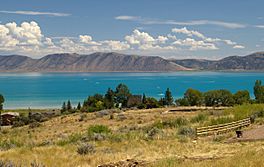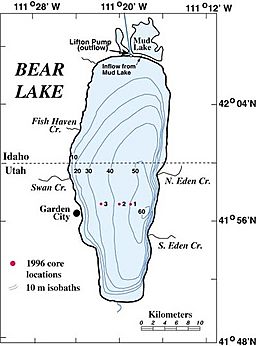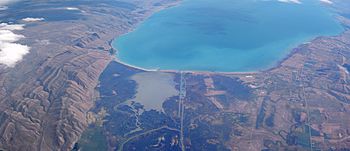Bear Lake (Idaho–Utah) facts for kids
Quick facts for kids Bear Lake |
|
|---|---|

The lake's intense turquoise color is due to
the presence of suspended limestone |
|

Bathymetric chart
|
|
| Location | Bear Lake County, Idaho Rich County, Utah, U.S. |
| Coordinates | 42°00′N 111°20′W / 42.000°N 111.333°W |
| Primary inflows | Creeks: Fish Haven, North Eden, South Eden, Swan Creek, St. Charles |
| Primary outflows | Bear Lake Outlet Canal |
| Catchment area | 5,862,957 acres (23,727 km2) |
| Basin countries | United States |
| Max. length | 18.3 mi (29.5 km) |
| Max. width | 7.1 mi (11.4 km) |
| Surface area | 109 sq mi (280 km2) |
| Average depth | 94 ft (29 m) |
| Max. depth | 208 ft (63 m) |
| Water volume | 6,500,000 acre⋅ft (8.02 km3) |
| Residence time | 19.6 years |
| Shore length1 | 48 mi (77 km) |
| Surface elevation | 5,924 ft (1,806 m) |
| Settlements | Garden City, Utah, Laketown, Utah, Fish Haven, Idaho |
| 1 Shore length is not a well-defined measure. | |
Bear Lake is a beautiful freshwater lake located right on the border between Idaho and Utah in the western United States. It's about 109 square miles in size, split almost equally between the two states. In Utah, it's the second-largest natural freshwater lake.
People often call Bear Lake the "Caribbean of the Rockies." This is because of its amazing turquoise-blue color. This color comes from tiny bits of limestone (calcium carbonate) floating in the water.
The lake is very old, more than 250,000 years! It was formed by the ground slowly sinking due to faults (cracks in the Earth's crust). This sinking still happens today, making the lake deeper on its eastern side.
Because of its special water, several unique kinds of animals live only in Bear Lake. These species can't be found anywhere else in the world.
An explorer named Donald McKenzie first explored the lake in 1819. He worked for the North West Fur Company. He originally called it "Black Bear Lake," but the name was later shortened to just Bear Lake. Today, the lake is a very popular spot for tourists and people who love sports. The valley around the lake is also famous for its delicious raspberries.
Contents
History of Bear Lake Valley
The first people known to live in the Bear Lake Valley were Shoshone tribes. However, many other Native American groups also knew about this area. The first time Europeans saw the lake was in 1818. French-Canadian trappers from the North West Company found it by following the Bear River upstream.
Mountain Men Gatherings
The southern part of the lake, near where Laketown is today, was a special meeting place. These meetings were called rendezvous, and they happened in the summers of 1827 and 1828. Mountain men like Jedediah Smith and Jim Bridger met there.
They gathered with people who supplied trade goods and American Indians from different tribes. The mountain men and Native Americans traded their furs for supplies and other items. They spent several weeks having fun with games and celebrations.
Jedediah Smith's arrival in June 1827 was very important. It marked the first time someone had traveled all the way to California and back to the United States overland. He wrote in his journal that his return caused a big stir because everyone thought he and his group were lost.
Pioneer Settlements
The Oregon Trail passed north and east of Bear Lake. Many pioneers traveled this trail between 1836 and the 1850s. But it seems none of them went far enough south to see the lake.
It wasn't until 1863 that Mormon pioneers arrived. They were led by Charles C. Rich. They settled in the Bear Lake Valley. They made an agreement with the Native Americans. This agreement meant that most of the Utah part of the valley stayed with the Native Americans.
Over time, the Mormons slowly moved south. They started villages along the lake's shore. These villages include Garden City, Pickelville, and Laketown.
Bear Lake as a Resort Area
In later years, Bear Lake became a popular place for vacations and fun activities. Many people started selling land near the lake and in the mountains. This was for new homes and developments.
In the 1970s, beaches like Lakota and Ideal were sold for private developments. These included the Blue Water and Sweetwater areas. The State of Utah bought the far southeast beach to use as a state park. The state also runs a marina on the west side of the lake.
As more development happened, people became worried about the environment. The lake has a dike on the Idaho side. Water users downstream on the Bear River use the lake as a reservoir to store water.
Geographic Features of Bear Lake
Bear Lake is located in a valley that crosses the Idaho-Utah border. This valley is shaped like a "half graben," which means one side of the valley has dropped down. The lake covers about 109 square miles. It sits at an elevation of about 5,924 feet. It is on the northeast side of the Wasatch Range and the east side of the Bear River Mountains.
Popular Tourist Destination
The lake and the areas around it are very popular for summer tourism. Bear Lake has many marinas and beaches. There are two main tourist towns in Utah: Garden City and Laketown.
There are also two state parks named Bear Lake State Park. One is in Idaho, and one is in Utah. The Utah state park has Rendezvous Beach, which is half a mile long. This beach is at the south end of the lake. It's where the 1827 and 1828 Rocky Mountain Rendezvous took place.
The Utah park also has Cisco Beach, which is three miles long on the east side. Plus, it has campgrounds, a marina, and boat ramps. The Idaho state park has a north unit and an east unit. Each of these units has a one-mile-long beach. The Bear Lake National Wildlife Refuge is located at the north end of the lake.
Unique Animals of Bear Lake
Bear Lake is special because it has many endemic species. Endemic means these animals are native to the lake and are not found naturally anywhere else. Several types of fish developed only in the lake's waters.
However, some of these unique species became extinct after the Bear River was redirected into the lake. But some endemic fish species still survive today. These include the Bear Lake strain of the Bonneville cutthroat trout, Bonneville cisco, Bonneville whitefish, Bear Lake whitefish, and Bear Lake sculpin.
People have tried to move these fish to other places, but it hasn't worked well. The only exception is the Bear Lake Cutthroat Trout. This trout has done well in other large, cool bodies of water, like the Strawberry and Scofield reservoirs.
The Bonneville cisco fish eat only tiny water bugs called zooplankton. In turn, bigger fish in the lake eat the Bonneville cisco. These include whitefish, Bonneville Cutthroat Trout, and lake trout that were brought into the lake. Even though several fish species have been introduced, the native species that survived the Bear River diversion are still doing well thanks to careful management.
The water from Bear Lake is used for irrigation in the nearby Bear Valley in southeast Idaho. It's also used for recreational fishing. The lake's water flows out through the Bear River Outlet, which was finished in 1915. This outlet connects to the Bear River, which eventually flows into the northeast part of Great Salt Lake.
Raspberry Cultivation and Festival
Bear Lake is very famous for the raspberry crops grown in the valley around it. There's even an annual event called Raspberry Days festival. It's held in Garden City to celebrate the raspberry harvest, usually during the first week of August.
This festival is said to bring thousands of people from all over the world. It includes many fun activities like:
- rodeos
- parades
- fireworks
- dances
- A craft fair
- A "Miss Berry Princess contest"
- A raspberry recipe cookoff
- A talent show
- A fun run
- concerts
In 2001, most of the original Bear Lake Raspberry plants got a virus. Fewer than five acres survived. This virus almost completely wiped out the large berry business in Garden City. Farmers replaced some of the infected plants with new ones that were resistant to the virus.
Even though some new raspberry types are resistant to the virus, none produce fruit as juicy and sweet as the old plants. However, the raspberry business has grown back. Raspberries are now thriving again, mostly in the southern part of the valley.
Error: no page names specified (help). In Spanish: Lago del Oso para niños
In Spanish: Lago del Oso para niños




